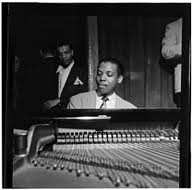
Daily Dose OF Jazz…
Gene Ramey, born April 4, 1913 in Austin, Texas, began playing trumpet in college but switched to the sousaphone when he played with George Corley’s Royal Aces, The Moonlight Serenaders and Terence Holder. It wasn’t until his move to Kansas City in 1932 that he took up the bass, studying with Walter Page.
Becoming a fixture in the Kansas City jazz scene, the double bassist played with Jay McShann’s orchestra from 1938 to 1943. Never a leader but a most sought after sideman, especially once he moved to New York, Ramey played with the who’s who of jazz including but not limited to Lester Young, Coleman Hawkins, Charlie Parker, Count Basie, Ben Webster, Hot Lips Page, Horace Silver, Thelonious Monk and Miles Davis.
His transition into bebop was easily accomplished due to the countless hours of daily practice with his friend Bird. They developed their style without drums, piano or other horns and Ramey was soon the first bassist to play the whole harmony chord while Bird ran his changes. Ramey is credited with stating that long before the jazz world started calling it bop he and Bird had created this pattern.
Ramey had a prolific career as a bassist for over three decades, never losing touch with Dixieland or swing as witnessed in his solos on recording sessions. Returning to Austin in 1976 his short-lived retirement led to lessons to local bassists, then to live performances and full-time musicianship until a heart attack caused his death on December 8, 1984.
More Posts: bass

Daily Dose Of Jazz…
Kenny Kersey was born on April 3, 1916 in Harrow, Ontario into a musical family and studied piano and trumpet while attending the Detroit Institute of Musical Arts. In 1936, Kersey moved to New York City where he played with Lucky Millinder, Billy Hicks, Frankie Newton, Billie Holiday, Roy Eldridge, Red Allen and Cootie Williams.
In 1942 he replaced Mary Lou Williams as Andy Kirk’s pianist and Kirk recorded his composition “Boogie Woogie Cocktail”. He joined the Army from 1943 to 1945, where he occasionally played trumpet in military bands, then played from 1946 to 1949 with the Jazz at the Philharmonic touring ensembles. He continued to play with noted musicians through the 1950s, including Eldridge and Allen again, as well as Buck Clayton, Edmond Hall, Sol Yaged, and Charlie Shavers.
Kersey retired from music late in the 1950s after being diagnosed with a bone ailment. He recorded twelve tunes as a bandleader – four for Savoy in 1946, two for Clef in 1949, two for Circle in 1950, and four for Foxy in 1951 which featured Hot Lips Page and Paul Quinichette and as sidemen. Kenny Kersey passed away on April 1, 1983 in New York City.
More Posts: piano

Daily Dose Of Jazz…
Abraham Samuel “Boomie” Richman was born on April 2, 1922 in Brockton, Massachusetts and began his career as a tenor saxophonist playing locally in his hometown. Moving to New York at twenty and within three years became a key soloist with the Tommy Dorsey Orchestra, a gig that lasted for six years at the height of the big band era. Playing a Selmer Tenor Mark VI saxophone with a baritone reed with a wide flare created a very expensive sound for the tenor who also played clarinet, bass clarinet, piccolo and flute.
Following his leaving the Dorsey band he were spent as a session player for the likes of Ella Fitzgerald, Tony Bennett, Nat King Cole, Frank Sinatra, Rosemary Clooney, Lena Horne, Sammy Davis, Benny Goodman, Peggy Lee, Judy Garland and Buddy Holly.
Richman played with Benny Goodman off and on throughout the early fifties. Upon his retirement from Goodman in 1956, he became the ‘first-call’ studio ace in New York City recording for television and radio commercials. This had him playing on shows hosted by Jimmy Dean, Perry Como, Dick Cavett, Patti Page, Pat Boone and Andy Williams. His last recording was for the movie The Godfather. His swing-based style remained unchanged well into the eighties when he retired from the music scene.
More Posts: saxophone

Daily Dose Of Jazz…
In the jazz world his moniker was Duke Jordan but he was born Irving Sidney Jordan on April 1, 1922 in Brooklyn, New York. The gifted and imaginative pianist was well known for his work with Charlie Parker during his classic quintet years with Miles Davis. From the 50’s on he had a long solo career performing in trio format after playing for periods with Sonny Stitt and Stan Getz. His most notable composition Jordu became a jazz standard when Clifford Brown adopted it into his repertoire.
He married the talented jazz singer Sheila Jordan in 1952 and the union lasted for a decade. He continuously performed throughout the sixties although he faded from the public eye until he began recording an extensive sequence of albums for Steeplechase in 1973 producing some of his best live recordings.
In 1978 he moved his residence to Copenhagen, Denmark where he lived until his death on August 8, 2006. His music always reflected the inherently melodic style that was enlivened by his delightful crisp touch and unexpected turns of phrase. Duke Jordan’s recordings can be found on Prestige, Savoy, Blue Note, Charlie Parker Records, Muse, Spotlite and Steeplechase.
More Posts: piano





